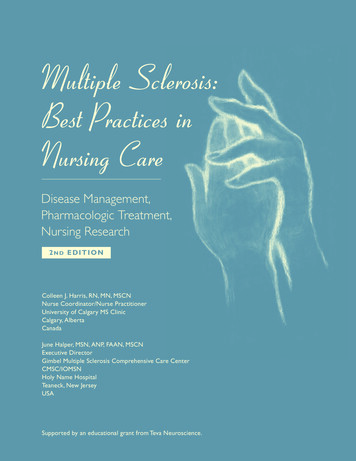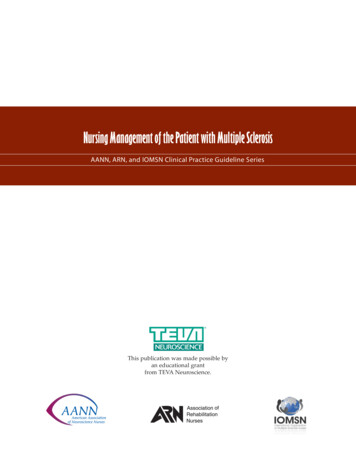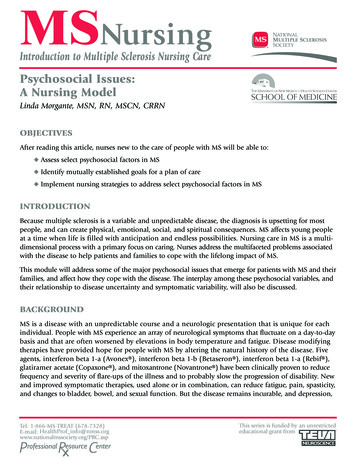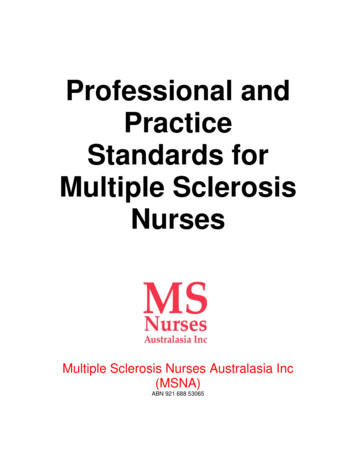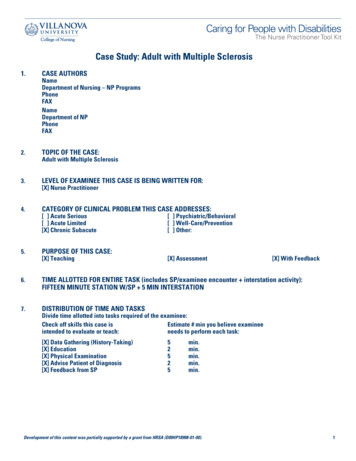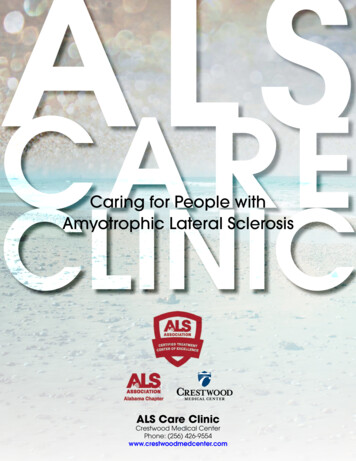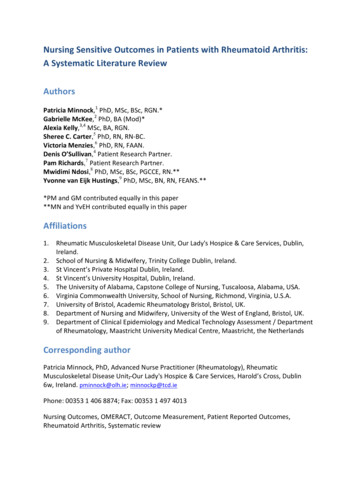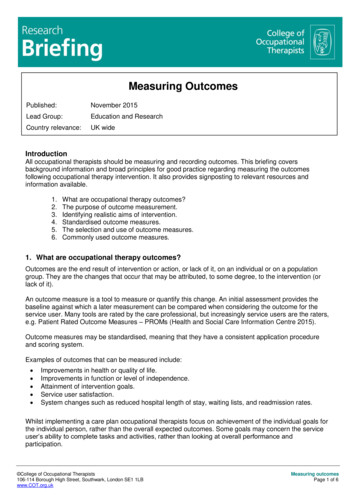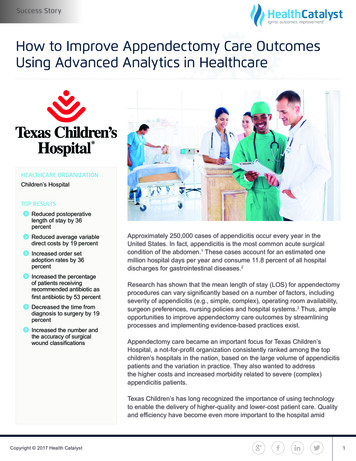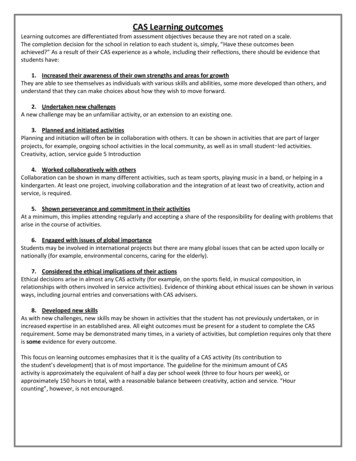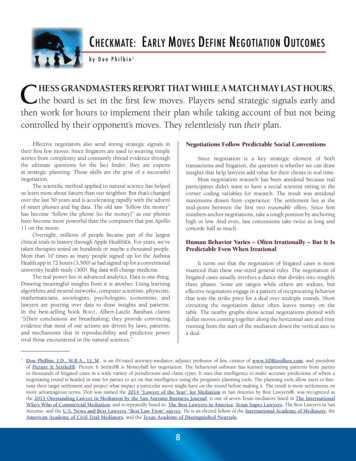
Transcription
J Neuro Rehab 1993;7:131-1370 1993 Demos PublicationsNursing Outcomes in Multiple Sclerosis'Lucinda S. Phair, R.N., M.A., and 2Nancy J. Holland, R.N., Ed.D.Measurement of patient outcomes is an implicitresponsibility of health care providers for all interventions. This process should guide plans for care and decisions about interventions so that efforts are focused o ngoal achievement, with measurable markers of success.There are external factors influencing particular attentionto outcomes at this time. The difficult economic climateemphasizes the need for effective and efficient care,demonstrable in outcome assessment. Also, pendinghealth care reform will most likely seek to incorporateproven models into the new system.Current Status of Nursing Outcomes inMultiple SclerosisThe most appropriate management of MS symptomsis described in the literature ( B a n d , Troiano, Dowling,Barbieri-Berser, Rocowsky-Kochan, Cook, 1993;Scheinberg, Smith, 1987). Not addressed is reference toquantifiable patient outcomes and their measurement.Although nurses have traditionally developed plans ofcare (McDonnell, Holland, Wiesel-Levison, 1980;Holland, McDonnell, Wiesel-Levison, 1981), efforts atmeasurement in MS have been modest. Smeltzer lookedat the Corbin and Strauss trajectory model of nursing todemonstrate the strengths and limitations relative to MS(Smeltzer, 1991). Another example of a recent effort toaddress nursing outcomes, although not specific to MS, isa study of 2,403 home health clients by Martin and colleagues. This study supported the usefulness of an evaluation tool called the Omaha System in describing andquantifying nursing practice in the community (Martin,From the 'Faitview Multiple Sclerosis Center, Minneapolis, MN;and *Vice President, Client Community Services, National MultipleSclerosis Society, New York,NY.Address correspondenceand reprint requests to: Lucinda S. Phair,R.N., M.A., The Fairview MS Center, 701 25th Avenue South,Minneapolis. MN 55454.Scheet, Stegman, 1993). Other generic systems of nursing outcomes have been developed and are in use (Waltz,Strickland,l988; Marek,1988; Moritz,l991). Such toolsand systems should be explored relative to the particularfeatures of the MS population and their applicabilityacross the continuum of health care settings where people with MS appear. To evaluate outcomes of care withinany existing or proposed models, specific parameters mustbe identified in advance. The challenges to nurses whocare for MS patients are to: 1) recognize the importanceof establishing and measuring outcomes; 2) translate nursing activities with MS clients into identifiable outcomes;and 3) consistently use this component in nursing practice. Although standardization is complicated by thediversity and fluctuation of MS symptoms, common factors related to problems and desired outcomes can beidentified and addressed.Utilizing the nursing diagnosis taxonomy proposed bythe North American Nursing Diagnosis Association(NANDA) (Carpenito, 1993; Gordon, 1993), five general areas of nursing outcomes particularly pertinent tothe MS patient, will be briefly discussed. Short- and longterm outcomes will be suggested for each of these diagnostic categories.Alteration in Elimination: BladderBladder problems are common in MS, existing in asmany as 80 percent of all MS patients (Blaivas, Bhimani,1979; Beck, Warren, Whitman,l981; Philp, Read, Higson,1981.; Goldstein, Siroky, Sax, Krane,1982). Bladderdysfunction is classified as primary (directly correlating tospecific lesions) or secondary (arising from inadequatemanagement of primary symptoms). Urinary tract infection is the major source of secondary dysfunction and islargely preventable.The basic physiologic mechanisms of bladder dysfunction in MS and resulting symptoms are well documented (Blaivas,1982; Blaivas, Sinha,I981). Commonsymptoms include:J NEURO REHAB, VOL.7, NO.314, 1993131
L.S. PHAlR AND N.J . HOLLANDFrequency-an increase in the number of times urination occurs, usually greater than every two to threehours.Urgency-the feeling of having to empty the bladderimmediately, often with a low volume of urinepresent in the bladder.Dribbling-leakage of small amounts of urine, usuallyassociated with urgency and/or inability to “hold”the urine until a toilet can be reached.Hesituncy-difficulty initiating a voiding stream,often despite an associated sense of urgency.Incontinence-involuntary loss of large amounts of urinewith or without conscious awareness of the need tovoid.Nocturia-awakening more than once during thenight because of an urge to urinate.Three practical classifications of MS bladder dysfunction from which these symptoms arise are:1. Spastic ur “fuilureto store’Jdysfitnction. The detrusor is hyperactive with uninhibited contractionsthat stimulate an urge to void despite a lowbladder volume ( 200mL). Symptoms mayinclude urgency, frequency, dribbling, nocturia,or incontinence.2. Flaccid or “fuilure to empty” bladder. The detrusor is usually hypo- or atonic with inadequateemptying contractions and residual urine.Associated symptoms parallel “failure to store”bladder with possible urgency, hesitancy, frequency, and incontinence, sometimes withoutawareness of the need to void.3. Dyssynergic or combined bladder dysfunction. Thedetrusor and external sphincter do not functiontogether smoothly to facilitate normal emptying.The sphincter contracts instead of relaxes duringexpulsive detrusor contractions, thereby obstructing free flow of urine from the bladder. Resultantincomplete emptying (despite urgency) may precipitate urinary tract infection or calculi formation, which are also risks with the “failure ‘toempty” type of bladder dysfunction. Symptoms’may include any of those already mentioned.A critical point is the inability to identify the type ofbladder dysfunction based on symptoms alone (Blaivas,1979; Goldstein et al., 1982; Katz, Blaivas, 1984). Thisunderscores the need to identify the underlying pathology before initiating any type of intervention. Secondarydysfunction or complications can become serious healththreats; e.g., urinary tract infection can easily develop ina bladder compromised by inadequate emptying. In astudy involving forty-nine MS clinic patients, Wahlquist132J NEURO REHAB, VOL. 7, NO.314,1993found that greater disability was associated with longerinpatient hospitalization, primarily due to febrile urinarytract infection (Wahlquist, 1984).Since many MS patients report bladder problems asone of the more disabling aspects of the disease, not onlyfrom a “health-disease” viewpoint but also socially andvocationally, it is imperative that patient outcomes relateto appropriate management of primary and secondary dysfunction. Long-term outcomes indicative of successfulmanagement would be:Patient control of bladder function through use ofthe most effective/least potentially harmful means,ranging from medications and intermittent selfcatheterization to indwelling Foley catheterlsuprapubic drainage.Freedom from urinary tract infection.In summary, the patient should be dry, free fromaccidents, and without urinary tract infection.Given the variability of the disease, consistentachievement of long-term outcomes is problematic.short-term outcomes are also important because theyguide treatment decisions to facilitate long-term goals. Forexample, post-void residual urine volumes (PVR) are critical indicators in addressing bladder management. Sincenormal bladder capacity is 350-500 mL, a PVR of greaterthan 100 mL may be indicative of failure to empty orcombined dysfunction. Maintaining a PVR of lo0 mLmay reduce the symptoms as well as the likelihood of secondary complications such as urinary tract infection.Intravenous pyelogram (IVP), ultrasonography, radioisotope studies, or a simple post-void catheterization aremeans of determining PVR in current practice. Thus, ashort-term outcome would be:Maintains a post-void residual urine volume of lo0 mL.Medication: BladderSymptom management through the use of medications is common. Anticholinergic medications such aspropantheline bromide and oxybutynin chloride and thetricyclic imipramine are effective in managing symptomsassociated with the “failure to store” bladder and may becombined with intermittent catheterization for handlingthe combined dysfunction bladder (Blaivas, 1979). If thelong-term outcomes are to be achieved through thismeans, the purpose and self-administration directions foreach medication must first be understood.Short-term outcomes specific to nursing in this areamay include:
NURSlNG OUTCOMES IN MSDemonstrates knowledge and appropriate use ofmedications.Takes medications at appropriate times.Monitors the effects of medications on symptomsand for possible adverse effects.Clean intermittent self-catheterization is the mosteffective way to manage emptying dysfunction. A nindwelling or suprapubic catheter may be required whenintermittent self-catheterization is not achievable due tocoexisting problems such as severe spasticity in the legs orupper extremity tremor and/or incoordination. However,it should be noted that many people with MS are successful with self-catheterization techniques, despite theseimpairments, through such means as stabilization of theforearm on the thigh to control tremor.Short-term outcomes that address these issues mayinclude:Performs intermittent self-catheterization:1. at appropriate intervals;2. using appropriate technique.Demonstrates correct care of self-catheterizationequipmentUtilizes appropriate techniques to maintain freedom from infection.Monitors for signs and symptoms of infection:1. urine: cloudy, foul-smelling, blood-tinged;.2. symptoms: dysuria, increased urgency, frequency,nocturia, increased spasticity.Many short-term patient outcomes fall within thescope of nursing practice. This paper does not identify allsubcategories of short-term outcomes, but the authorsbelieve this should be addressed at a later time. However,regardless of the treatment modality required, short-termoutcomes must focus on the patient's mastery of the necessary knowledge and skills if long-term outcomes are tobe achieved. This is primarily a nursing function thatrequires nursing attention and accountability.Alteration in Elimination: BowelBowel problems in MS are often associated with bladder dysfunction since both functions share common neurologic pathways. Bowel dysfunction may present as eitherconstipation or incontinence. As with bladder problems,patients cite bowel symptoms, especially instances ofincontin'ence, as having a major impact on social, vocational, and psychological well-being.The prevalence of bowel dysfunction is less clearlydefined than the prevalence of bladder dysfunction. Manypatients tend to minimize or deny its existence, sometimesout of embarrassment or because they attribute the causeto something other than MS. Constipation has beenreported in 39-53 percent of MS patients (Miller,Simpson, Veates,1965; Sullivan, Ebers,1982). A morerecent study found constipation and/or incontinence in asmany as 68 percent of patients interviewed, with constipation the most frequently identified problem. (43 percent) (Hinds, Eidelman, Wald, 1990). Thus, the importance of focusing on outcomes related to managingconstipation or incontinence is apparent.Decreased colonic motility, absence of a perceivedneed/urge to defecate, and actual weakness resulting in aninability to evacuate stool all contribute to constipationin the MS patient. Compounding this may be a decreasedactivity level and lack of exercise, as well as a volitionalcurtailing of fluid intake in an attempt to control bladderproblems.Although less frequent, incontinence is often moreproblematic to the patient because of the social implications and stigma associated with lack of bowel control.With decreased anal sphincter tone and impaired perception of colonic filling, the patient may be unaware ofthe need to defecate until it becomes urgent. This alone,or in combination with impaired physical mobility, canlead to incontinence.Patient outcomes are aimed at eliminating or lessening the intensity of the symptoms. Establishing predictability is the key to successful bowel management,whether it be through dietary adjustments, medication, orbowel patterning or training. Thus, long-term outcomesrelated to satisfactory bowel control are similar in substance to those of bladder control:Patient control of bowel function (predictableand comfortable bowel evacuation) through theuse of dietary additives, medications, or otherevacuation aids.Freedom from bowel accidents/incontinence.Adequate hydration (8-10 glasses of liquid a day)combined with dietary or supplemental fiber is adequateto facilitate normal evacuation in some instances of constipation. Stimulants, both oral (e.g., Perdiem or Pericolace) and rectal (e.g., glycerin or Dulcolax suppositories), may be needed if fiber additives and increasedfluid intake are not sufficient to promote evacuation(Schapiro, 1994)Consideration should be given to dietary preferencesand food allergies/intoleranceswhen identifying and measuring short-term outcomes. Intolerance to certain foodssuch as fat or lactose, for example, may cause diarrhea,which then negates the effects of prescribed interventions.Incontinence requires patterning or training sinceunpredictability and urgency are part of the underlyingNEURO REHAB, VOL. 7, NO. 3/4, 1993133
L . S.PHAlR AND N.J. i-IOLLANDproblem, especially in cases in which mobility is impaired.If the stool is loose or unformed, addition of a bulk-formerwith limited oral liquids acts to firm the stool, therebyaffording more time to reach the toilet. The daily or alternate day use of a suppository at a consistent time begins thepatterning routine and ensures a predictable time of evacuation and, thus, control (Holland, Francabandera,l987).Anticholinergic medication may also be needed.As in the case of bladder dysfunction, short-term outcomes are importan
Nursing Outcomes in Multiple Sclerosis 'Lucinda S. Phair, R.N., M.A., and 2Nancy J. Holland, R.N., Ed.D. Measurement of patient outcomes is an implicit responsibility of health care providers for all interven- tions. This process should guide plans for care and deci- sions about interventions so that efforts are focused on goal achievement, with measurable markers of success. There are .
